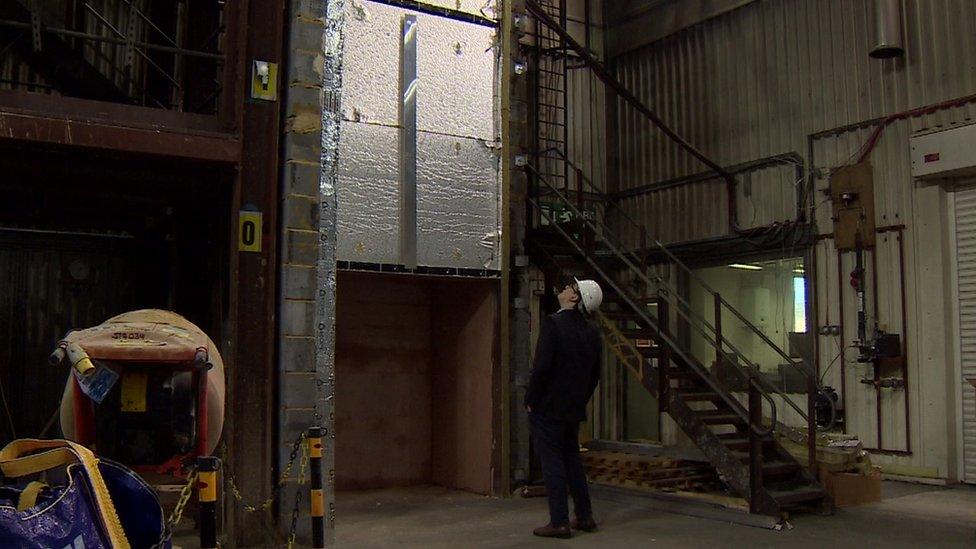Grenfell-style cladding design fails official fire test
- Published

An official test of the types of materials used at Grenfell Tower suggest that designs like that used in the tower's cladding are fundamentally flawed, Newsnight can reveal.
A so-called "fire test" is intended to establish whether a design would withstand fire if installed perfectly.
The Grenfell cladding has been blamed for the fire's rapid spread.
The local government department stated they aimed to "publish results as soon as possible".
This test is the first full-scale test of the combination of insulation and cladding of the types used at Grenfell. The test involves setting a fire underneath a large-scale mock-up of the insulation system in a fire laboratory.
Previous tests have only sought to establish what types of materials have been installed on high-rises across England. This test is the first in a series that is intended to work out which combinations of materials can safely be installed together and which cannot.
Chris Cook: "The test was an absolute failure"
The test result makes it more likely that the choice of materials in use at Grenfell Tower, rather than poor installation of the cladding, was to blame for the fire's spread across the face of the building. People familiar with the results stated that it also supports the conclusion that the cladding was the critical component that spread the fire.
This test, conducted by the Building Research Establishment near Watford, will be followed by five others, each of which will use a different combination of insulation and exterior aluminium panelling. This first test used a so-called PIR plastic foam, a type of combustible insulation, and aluminium panels with a combustible polyethylene plastic core.
This is the most flammable of the six combinations of insulation and exterior cladding that will be tested. While other buildings with this combination have been identified, this specific combination of PIR foam and polyethylene-core cladding is not currently believed to be in widespread use.
Most buildings that have been found to have suspect cladding will not be installed with this combination of materials.
A spokesman for the Department for Communities and Local Government said: "We've already issued practical advice so that landlords can make properties safe for residents, and our priority now is informing landlords of the latest results so that they can take any further actions that are necessary."

The test rig at the BRE before the alumnium cladding was installed, showing the interior design of the cladding. The silver foil covers the insulation. The vertical yellow stripes are firebreaks intended to stop the fire moving horizontally. The black stripes are firebreaks designed to stop vertical fire spread
This test result, however, raises major questions about why this combination of materials was actually signed off by building control officers.
The fire test conducted by the BRE is a standard test which is designed to establish whether a specific combination of materials, installed in a specified fashion, will be safe during a fire.
If developers wish to use combustible material on the exterior of tall buildings, it is supposed to be on the basis of data from such a test.
Newsnight has, however, previously revealed how developers have installed combustible elements on tall buildings without having tested the components.
They can commission engineers to write reports arguing that the material is functionally similar to material that has already been tested.
Or, in one case, Newsnight found building inspectors willing to sign off material of the same combustibility as at Grenfell without even that level of evidence.
The publication of this test makes it impossible for this design and combination of materials to be used in future without it passing a further test.

Fire test rig used at the BRE, with reporter for scale
Newsnight has also previously revealed concerns about the adequacy of the testing regime - not least because test data is usually confidential and therefore difficult for fire safety officials to scrutinise.
The test is also conducted on a test bed which has been installed slowly by cladding engineers over several days.
In reality, material may be installed hastily, and may be damaged in installation or use in ways that reduce their fire safety.
Newsnight has also revealed that the government has begun work on a review of building standards.
The decision reflects official alarm at the state of building safety in the wake of last month's Grenfell Tower fire, in which at least 80 people died.
As results of checks on tall buildings have come in, civil servants have expressed shock at how the official rulebooks have been interpreted.
They remain unclear whether the problem is the rules or their enforcement.